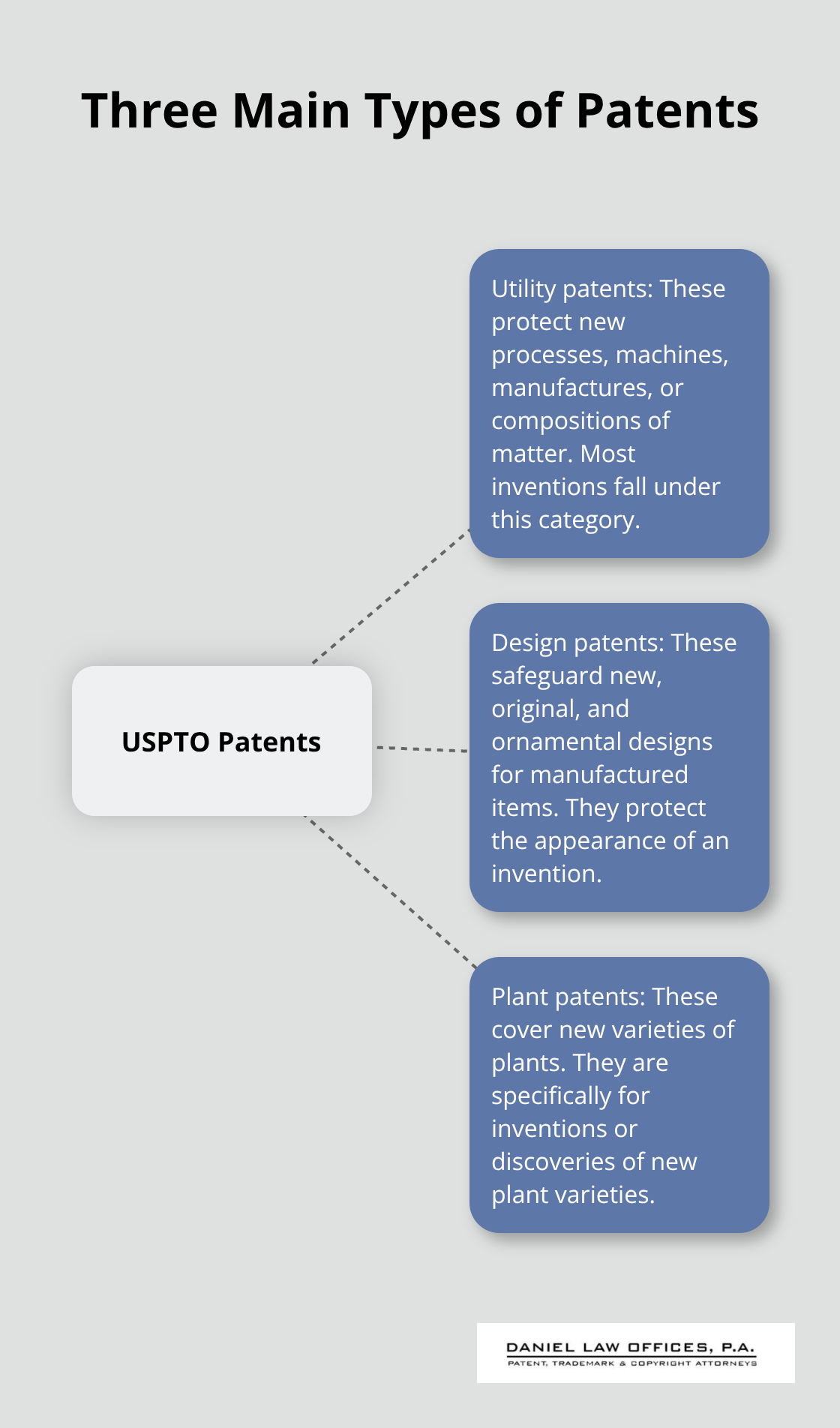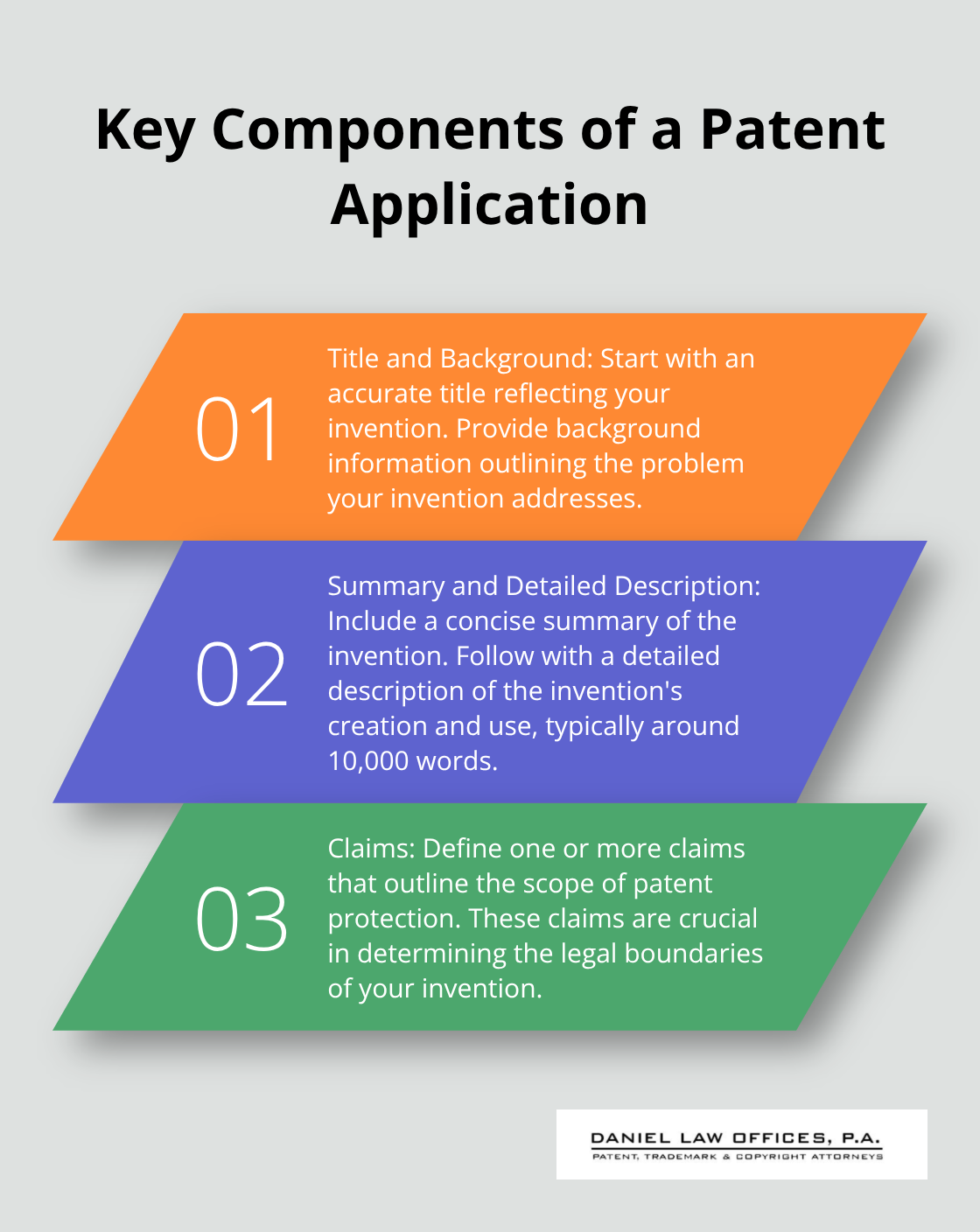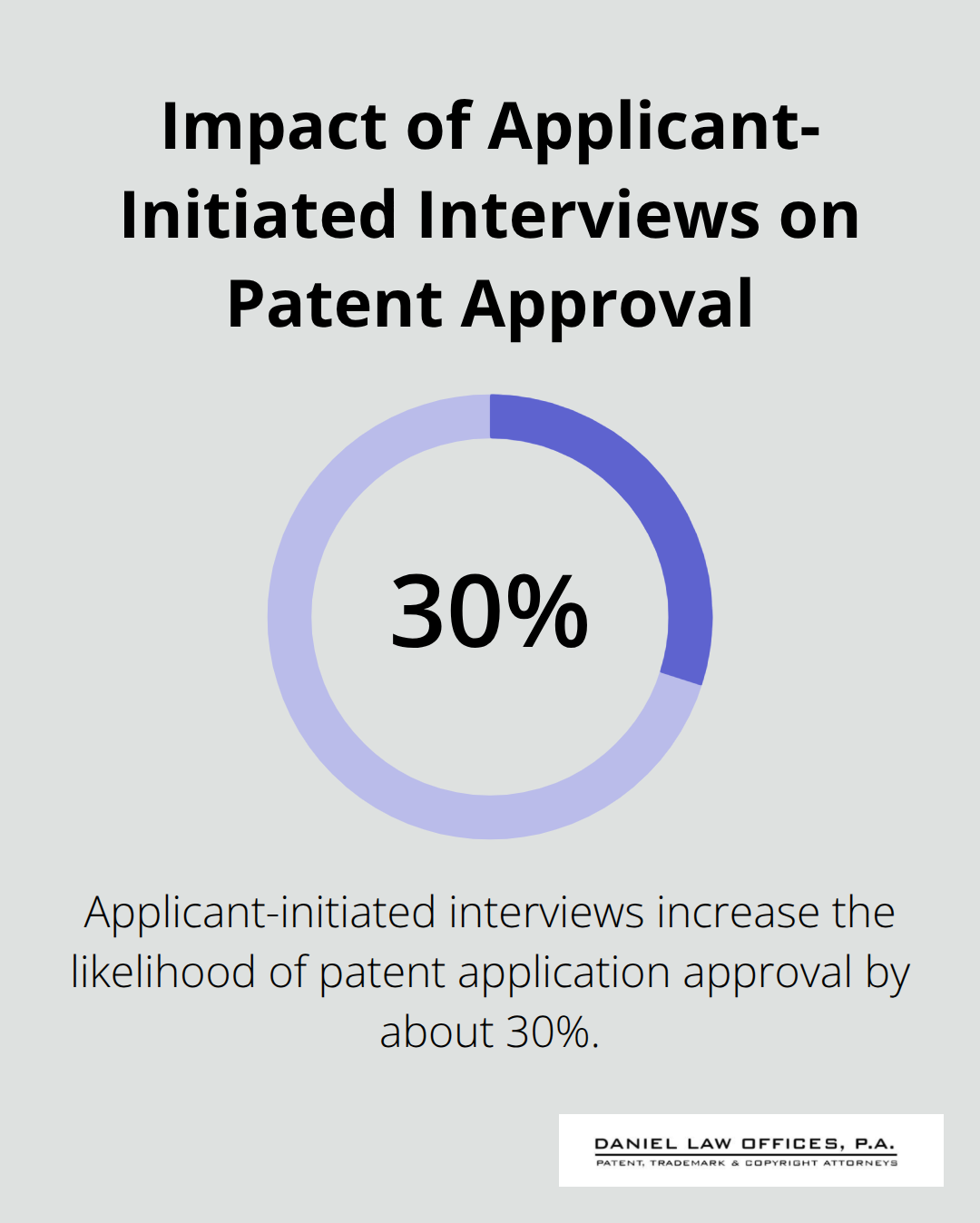Patent Filing Process Flowchart for Orlando, Florida [Visual Guide]
At Daniel Law Offices, P.A., we understand the complexity of the patent filing process. This visual guide simplifies the journey for inventors in Orlando, Florida.
Our patent filing process flowchart breaks down each step, from initial research to final approval. We’ll walk you through the key stages, helping you navigate this intricate process with confidence.
How to Start Your Patent Journey
Conducting a Thorough Patent Search
The first step in your patent journey involves a comprehensive search. This search helps you determine if your invention is truly novel. The United States Patent and Trademark Office (USPTO) offers a free database for this purpose. However, navigating this database can challenge non-experts.
Professional patent search services can uncover existing patents or published applications similar to your invention. This step prevents you from spending money on an application that the USPTO might reject due to lack of novelty.
Documenting Your Invention
After you confirm your invention’s uniqueness, you must document it meticulously. This documentation (often called an “invention disclosure”) should include:
- A detailed description of your invention’s functionality
- Sketches or diagrams illustrating its components
- Test results or prototypes you’ve developed
- The problem your invention solves and its unique solution
This documentation serves two purposes:
- It helps patent attorneys fully understand your invention when drafting the application
- It can serve as evidence of your invention date in legal proceedings
Selecting the Appropriate Patent Type
The final initial step requires you to determine which patent type best suits your invention. The USPTO offers three main types of patents:

- Utility patents: These protect new processes, machines, manufactures, or compositions of matter
- Design patents: These safeguard new, original, and ornamental designs for manufactured items
- Plant patents: These cover new varieties of plants
Most inventions fall under utility patents, but choosing correctly is vital. The wrong patent type can result in inadequate protection for your invention.
Seeking Professional Guidance
While these initial steps might seem straightforward, they can significantly impact the success of your patent application. Many inventors find value in consulting with a patent attorney during this phase. A professional can provide valuable insights, help you avoid common pitfalls, and increase your chances of success.
At Daniel Law Offices, P.A., we offer expert guidance through each of these initial steps. Our team can help you navigate the complexities of patent searches, documentation, and patent type selection.
As we move forward, let’s explore the next phase of the patent filing process: preparing and submitting your application to the USPTO.
How to Prepare and Submit a Patent Application
Craft a Comprehensive Patent Application
The patent application forms the cornerstone of your intellectual property protection. This document must explain your invention with such precision that a skilled professional in your field could recreate it based solely on your description. The USPTO reports that an average patent application contains approximately 10,000 words.
Your application should encompass:

- An accurate title reflecting your invention
- Background information outlining the problem your invention addresses
- A concise summary of the invention
- A detailed description of the invention’s creation and use
- One or more claims that define the scope of patent protection
Illustrate Your Invention with Patent Drawings
Visual representations play a vital role in patent applications. The USPTO states that over 90% of patent applications include drawings. These illustrations must clearly depict every feature of the invention mentioned in the claims.
Essential guidelines for patent drawings include:
- Use black ink on white paper
- Label all parts with reference numbers
- Provide different views (top, side, perspective) as necessary
- Ensure drawings remain clear and legible when reduced to two-thirds their size
Submit Your Application to the USPTO
After finalizing your application and drawings, you must file them with the USPTO. In 2020, the USPTO received more than 650,000 patent applications. To avoid common mistakes, follow these steps:
- Review all forms for completeness
- Verify correct listing of all inventors
- Include a signed oath or declaration from each inventor
- Submit your application electronically through the USPTO’s EFS-Web system
Pay the Required USPTO Fees
Filing fees vary based on the patent type and the size of the entity applying. As of 2023, basic filing fees for a utility patent range from $80 for micro entities to $320 for large entities (with small entities paying $160).
Additional fees apply for extra claims, late filings, or expedited processing. Budget for these costs in advance to prevent delays in your application process.
The patent application process presents numerous challenges, but with proper guidance, you can navigate it successfully. Our next section will explore what happens after you submit your application, including the examination process and how to respond to USPTO feedback.
What Happens After Filing Your Patent Application?
Receiving an Office Action
The USPTO initiates the examination process after you submit your patent application. This phase can last from several months to years (depending on the invention’s complexity and USPTO workload). The first significant communication from the USPTO is an Office Action. This document outlines the examiner’s initial assessment of your application. USPTO data indicates about 86% of patent applications receive at least one non-final Office Action.
Office Actions typically fall into two categories:
- Non-Final Office Action: This initial feedback may raise objections or rejections based on prior art, clarity issues, or other concerns.
- Final Office Action: The examiner may issue this if they believe your responses to the non-final action haven’t fully addressed their concerns.
Responding to Examiner’s Feedback
You have a limited time to respond to an Office Action (usually within six months). Your response should address each point raised by the examiner thoroughly and persuasively.
Key elements of an effective response include:
- Clarification of misunderstandings about your invention
- Evidence of novelty or non-obviousness
- Amendments to claims to overcome rejections
- Arguments supported by patent law and precedents
Revising Your Application
The examiner’s feedback may necessitate revisions to your application. This could involve:
- Amendments to claims to narrow or clarify their scope
- Addition of new claims to cover aspects not initially included
- Revisions to the specification to provide better support for your claims
Any changes must be supported by your original disclosure. You can’t add new matter that wasn’t present in your initial application.
Negotiating with the Examiner
Persistent disagreements after your initial response may require negotiation with the examiner. This often involves scheduling an interview (in person or over the phone).
During these discussions, you can:
- Clarify aspects of your invention
- Propose claim amendments
- Address the examiner’s concerns directly

USPTO statistics show that applicant-initiated interviews increase the likelihood of application approval by about 30% (a significant boost to your chances of success).
The examination phase requires patience and persistence. It’s not uncommon for applications to go through multiple rounds of Office Actions before reaching a resolution. However, with the right approach and expert guidance, you can navigate this process successfully and secure the patent protection your invention deserves.
Final Thoughts
Our patent filing process flowchart provides a clear roadmap for inventors in Orlando, Florida. This visual guide simplifies the complex journey from initial research to final approval. We understand the challenges inventors face and offer expert assistance to navigate the intricacies of patent law.
At Daniel Law Offices, P.A., we help you avoid common pitfalls, craft strong applications, and respond effectively to USPTO feedback. Our team of registered patent attorneys commits to protecting your innovative ideas. We ensure your inventions receive the legal safeguards they deserve.
The path to patent approval may seem daunting, but with the right knowledge and support, you can succeed. Our professional guidance (available throughout the entire process) will equip you to turn your innovative ideas into protected intellectual property.

![Patent Filing Process Flowchart for Orlando, Florida [Visual Guide]](https://danielpatents.com/wp-content/uploads/emplibot/Patent-Filing-Process-Flowchart-for-Orlando_-Florida-_Visual-Guide__1756865214.jpeg)